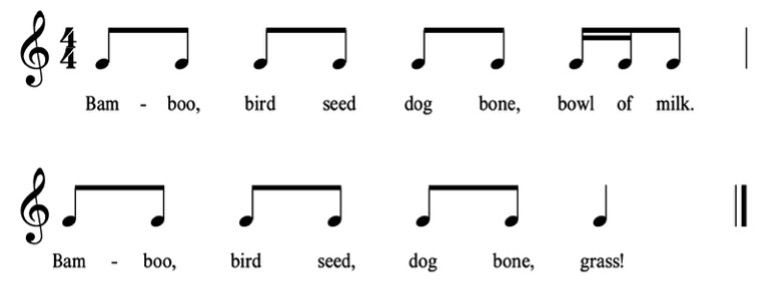
Prep. Lesson 6. Consolidating the beat
- Bee puppet on a stick
- Djembe Difficulty:
 Prior learning: None
Prior learning: None
 This lesson is designed for early in the year, when many students are still learning to differentiate between their speaking and singing voices. Some may be hesitant to use their voices, particularly when responding individually. It’s crucial not to impose strict performance expectations during this activity. Recording students’ responses provides valuable insight into their current abilities—some may respond with a single spoken word, while others may engage in more elaborate melodic exchanges. Every response, whether simple or complex, should be accepted and encouraged. This approach fosters confidence and supports students as they develop their vocal and musical skills.
This lesson is designed for early in the year, when many students are still learning to differentiate between their speaking and singing voices. Some may be hesitant to use their voices, particularly when responding individually. It’s crucial not to impose strict performance expectations during this activity. Recording students’ responses provides valuable insight into their current abilities—some may respond with a single spoken word, while others may engage in more elaborate melodic exchanges. Every response, whether simple or complex, should be accepted and encouraged. This approach fosters confidence and supports students as they develop their vocal and musical skills.
![]()
Students review known material and extend exploration by creating musical conversations.
 Helpful Hint:
Helpful Hint:
Keeping a beat using body movements that align with 2/4 time means, as far as the students are concerned, they are just keeping a beat, but the nature of the 2-movement pattern (unconsciously) groups the beat into a duple metre.
 Success Criteria
Success Criteria
- I can sing and move to the beat in a two-movement pattern.
- I can suggest and practice new movement patterns.
- I can respond musically in an improvised conversation.
- I can participate actively and express myself in a group setting.
- Have students stand in a circle. Explain that they will sing a familiar song and follow movements to keep the beat.
- Sing the greeting song “Good Morning” and model the movements.
- Show students how to stretch up like a yawn on the first beat and drop forward on the second beat.
- Practice the movements together, ensuring students follow the pattern while keeping the beat.
- Ask students to suggest other two-movement patterns (e.g., tapping head and shoulders) to keep the beat and practice their suggestions.
- Sing the phrase “How do you feel today?” using the notes (s, m, m, s, s, m). Maintain a two-movement beat while singing.
- Allow students to respond all at once in any way they choose (e.g., clapping, singing back, or using hand gestures).
- Address one student specifically, singing “Good morning, <Name>. How do you feel today?” and await their response.
- Encourage students to respond in their own way, whether a spoken word, a sentence, or a sung phrase.
- Repeat and Rotate to continue the improvised conversation with different students, accepting all forms of response.
- Encourage everyone to participate and express themselves in a way that feels comfortable.
- Consider audio recording the activity for later assessment, focusing on students’ ability to keep the beat, participate in conversations, and respond musically.
![]() Students keep the beat and balance phrases by vocally responding to and creating musical questions in a musical call-and-response activity.
Students keep the beat and balance phrases by vocally responding to and creating musical questions in a musical call-and-response activity.
 Helpful Hint:
Helpful Hint:
While clearly seeking to achieve similar outcomes to ‘Good Morning’, this activity provides conceptual reinforcement through repeating ideas demonstrated within a new musical context. It also gradually transfers the activity’s decision-making to the students, who become in control of who is selected and initiate the musical question. The ‘bee-on-a-stick’ is an effective prop for this activity, as the bee can ‘fly’ around in the circle using fluid arm movements. It can be easily constructed by adhering a small toy to the end of a slim piece of dowel.

![]() Lyrics
Lyrics
Bee Bee, Bumble Bee,
Can you sing your name to me?
- Show the class the bee on a stick prop and explain that it will "fly" around the circle as they sing.
- Sing the song “Bee, Bee, Bumble Bee” while moving the bee prop in front of the students. Encourage them to join in once they are comfortable with the lyrics.
- Ask students to suggest 2-movement patterns to keep the beat (e.g., tapping knees and clapping hands).
- Practice these movements with the class while singing the song to maintain the beat.
- Move the bee around the circle as the class sings. When the song ends, stop the bee in front of a student.
- The student sings their response, “My name is <Name>”, and the class echoes, “Her/his name is <Name>”.
- The student who sang their name then takes control of the bee prop and chooses another classmate by singing the question, “Can you sing your name to me?”.
- Continue the activity, allowing different students to take turns leading with the prop.
- Praise students for participating and using their beautiful singing voices.
- Reinforce that it’s important to keep the beat and sing confidently, whether leading or echoing.
 Success Criteria
Success Criteria
- I can respond to a musical question by singing a musical answer.
- I can ask a musical question through accurately pitched singing.
- I can sing my name when prompted.
- I can echo my classmates' responses.
- I can keep the beat using suggested movement patterns.
![]() Students will learn to keep the beat using body movements and a djembe while singing a familiar song.
Students will learn to keep the beat using body movements and a djembe while singing a familiar song.
![]() Lyrics
Lyrics
I'm a bear, and I like honey,
Lots of honey in my tummy,
I'll feel sick, and I'll feel funny,
If I go on eating honey!
 Success Criteria
Success Criteria
- I can sing the song and keep a two-movement beat with body movements.
- I can transfer a steady beat pattern on the djembe using alternating hands.
- I can participate and take turns trying the new instrument.

- Begin with a discussion on what bees do and their importance. Guide the conversation toward bees making honey.
- Ask, “What animal do we know that likes honey?” (Prompt them to answer “Bear”).
- Teach or review the song “I’m a Bear and I Like Honey”. Sing the song together as a class.
- Encourage students to join in, focusing on keeping the beat while singing.
- Demonstrate the following 2-movement pattern for keeping the beat:
- Closed fists on top of the head (to mimic bear ears).
- Flat palms on the tummy (indicating the bear enjoying honey).
- Practice this pattern with the class, ensuring they move in time with the beat as they sing.
- Introduce the djembe and explain that it is a type of drum played with the hands.
- Demonstrate how sound is produced using an open palm on the centre of the drumhead for a deeper tone and closed fingers along the rim for a higher tone. Emphasise alternating hands to create a steady beat.
- Let students know that while they can try to create different tones, it’s not expected—just alternating hands is fine.
- Show how the 2-beat pattern can be played on the djembe. Play the beat while singing the song.
- Encourage students to practice the movements in the air first before trying it on the djembe.
- Invite students to come up individually and play the djembe, following the 2-beat pattern they learned.
- Provide guidance and positive reinforcement as they try to keep the beat with the djembe.
- Discuss with the students how playing the beat on the djembe felt compared to using their body movements.
![]()
Students create and perform short melodies, keep the beat, match animals with their favourite foods and add actions and sound effects.

- Begin by asking students to think of different animals and what they like to eat (e.g., cow/grass, dog/bone).
- Discuss examples as a class to help students brainstorm ideas.
- Distribute the animal cards to the students or display them on a board. These may be printed and laminated for further use. Alternatively, print the entire sheet or project on the board.
- Ask students to match each animal to what they like to eat. Encourage discussion and participation to ensure everyone is involved in matching the correct pairs.
- Once the animal and food pairs are established, challenge students to put one of these into a short melody.
- Demonstrate by singing an example, such as “I’m a cow, and I like grass”, to a simple melody.
- Ask students to add an action to their melody. For example, pretend to munch after singing about the cow eating grass.
- To make the activity more engaging and fun, include a sound effect after the line, such as “Munch, munch, munch!”
- Have students perform their melody, action, and sound effects for the class, either individually or in small groups.
- Discuss with the students what they enjoyed about creating and performing their melodies.
 Success Criteria
Success Criteria
- I can match animals with their favourite foods.
- I can create and sing a short melody with my animal and food pair.
- I can add an action and sound effect to my melody.
- I can share my creations with the class and participate actively.
![]() Students create and perform in a class arrangement in rondo form.
Students create and perform in a class arrangement in rondo form.
![]() Lyrics
Lyrics
A Section (Whole Class)
I’m a bear, and I like honey,
Lots of honey in my tummy.
I’ll feel sick, and I’ll feel funny
If I go on eating honey.
B Section
Student 1: ‘I’m a cow, and I like grass – munch, munch, munch!’
Student 2: ‘I’m a dog, and I like bones – ruff, ruff, ruff!’
Student 3: ‘I’m a bird, and I like birdseed – peck, peck, peck!’
Student 4: ‘I’m a cat, and I like milk – purr, purr, purr!’
A Section (Whole Class)
I’m a bear, and I like honey,
Lots of honey in my tummy.
I’ll feel sick, and I’ll feel funny
If I go on eating honey.
C Section
Next four students, etc.
- In this activity, students will incorporate the short melodic phrases they created in the last activity into a larger full-class arrangement.
- The song ‘I’m a Bear, and I Like Honey’ is used as the A section. The whole class performs it, accompanied by the djembe.
- The newly created segments form the B, C, D, etc. sections, each of which may comprise four individual creations.
- Create a class arrangement in rondo form with the known song, ‘I’m a Bear, and I Like Honey,’ as the A section.
- Students composed melodies comprise the B, C, D, etc. sections.
- Students may use animals and foods from the cards or create their own combinations.
- Four students can perform each section (B, C, D, etc.), taking one line each.
 Success Criteria
Success Criteria
- I can contribute to a group arrangement by performing my part accurately.
- I know when to come in with my part when performing in a group.

![]() Students will learn to move in time with a chant and connect beats with visual representations on a beat sheet.
Students will learn to move in time with a chant and connect beats with visual representations on a beat sheet.
![]() Lyrics
Lyrics

- Have the students walk to the beat as you chant the verse. Demonstrate how to step on each word while maintaining a steady pace.
- Students should step the quavers for the words “bamboo,” “bird seed,” and “dog bone. "
- On “bowl of milk,” students stand still and clap

- Students stand still on “grass” and stretch their hands out in front.
- Chant the verse a few times while the students practice the movements. Ensure they stay in time with the beat.
- Project the beat sheet with eight clumps of grass onto the board. Explain that each clump represents one beat in the chant.
- Point to each beat on the sheet as you chant, helping students visually connect the beats with the words and movements.
- Repeat the activity, pointing to the beat sheet while chanting and having the students follow the corresponding movements.
- Emphasise stepping on the quavers, clapping on “bowl of milk,” and stretching their hands for “grass.”
 Success Criteria
Success Criteria
- I can move in time with a chanted verse and perform the correct actions.
- I can chant the verse while following the beat as the teacher points to each clump of grass on the beat sheet.
Suggested lessons
Y1. Beat II

Y1. Beat III

Y1. Beat IV

